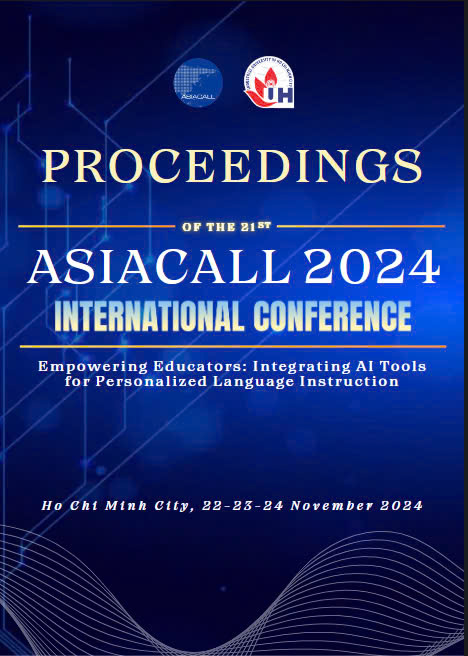An Investigation into Students' Perception of Using Call Annie as a Virtual Conversational Partner
DOI:
https://doi.org/10.54855/paic.24624Keywords:
AI, chatbot, students' perception, virtual conversational partnerAbstract
There is no doubt that using AI tools to learn a foreign language has become more common in recent years. This study aims to explore students’ perception of using Call Annie – an AI-powered tool – to practice speaking regularly, as part of their homework to find out their perceived advantages and disadvantages after conversing with the application. This research project employed 85 English majors at a university for the investigation, in which both quantitative and qualitative data were collected via questionnaires and interviews to observe their interactions with the Call Annie chatbot for homework assignments as conversational partners for three weeks. After the period, students were given surveys to record their perception, and after their final speaking test, a focus group interview was held with 3 students. Findings show students’ willingness and confidence to utilize Call Annie in the future for their speaking skills, as well as their positive attitudes. However, the data also shows that students were worried about using the tool due to concerns about authenticity and language content. In the future, AI chatbots may be used as conversational partners, which could enable teachers to take more active roles in individualized approaches to teaching speaking.
References
Allouch, M., Azaria, A., & Azoulay, R. (2021). Conversational agents: Goals, technologies, vision and challenges. Sensors, 21(24), 8448. DOI: https://doi.org/10.3390/s21248448
Almusaed, A., Almssad, A., Yitmen, I., & Homod, R. Z. (2023). Enhancing student engagement: Harnessing “AIED”’s power in hybrid education—A review analysis. Education Sciences, 13(7), 632. https://doi.org/10.3390/educsci13070632 DOI: https://doi.org/10.3390/educsci13070632
Babbie, E. R. (2020). The practice of social research. Cengage Au.
Belda-Medina, J., & Calvo-Ferrer, J. R. (2022). Using chatbots as AI conversational partners in language learning. Applied Sciences, 12(17), 8427. https://doi.org/10.3390/app12178427 DOI: https://doi.org/10.3390/app12178427
Berg, C. (2023). The case for generative AI in scholarly practice. Available at SSRN 4407587. https://papers.ssrn.com/sol3/papers.cfm?abstract_id=4407587 DOI: https://doi.org/10.2139/ssrn.4407587
Bibauw, S., François, T., & Desmet, P. (2019). Discussing with a computer to practice a foreign language: Research synthesis and conceptual framework of dialogue-based CALL. Computer Assisted Language Learning, 32(8), 827-877. https://doi.org/10.1080/09588221.2018.1535508 DOI: https://doi.org/10.1080/09588221.2018.1535508
Brown, H. D. (1994). Principles of language learning and teaching. Upper Saddle River, NJ: Prentice Hall.
Chan, C. K. Y., & Hu, W. (2023). Students’ voices on generative AI: Perceptions, benefits, and challenges in higher education. International Journal of Educational Technology in Higher Education, 20(1), 43. DOI: https://doi.org/10.1186/s41239-023-00411-8
Chan, C. K. Y., & Lee, K. K. (2023). The AI generation gap: Are Gen Z students more interested in adopting generative AI such as ChatGPT in teaching and learning than their Gen X and millennial generation teachers?. Smart learning environments, 10(1), 60. DOI: https://doi.org/10.1186/s40561-023-00269-3
Creswell, J. W., & Creswell, J. D. (2017). Research design: Qualitative, quantitative, and mixed methods approaches. Sage publications.
Creswell, J. W., & Clark, V. L. P. (2017). Designing and conducting mixed methods research. Sage publications.
Csizér, K., & Dörnyei, Z. (2005). The internal structure of language learning motivation and its relationship with language choice and learning effort. The modern language journal, 89(1), 19-36. DOI: https://doi.org/10.1111/j.0026-7902.2005.00263.x
Chen, Y., Jensen, S., Albert, L. J., Gupta, S., & Lee, T. (2023). Artificial intelligence (AI) student assistants in the classroom: Designing chatbots to support student success. Information Systems Frontiers, 25, 161–182. https://doi.org/10.1007/s10796-022-10291-4 DOI: https://doi.org/10.1007/s10796-022-10291-4
Crompton, H., & Burke, D. (2023). Artificial intelligence in higher education: The state of the field. International Journal of Educational Technology in Higher Education, 20(1), 22. https://doi.org/10.1186/s41239-023-00392-8 DOI: https://doi.org/10.1186/s41239-023-00392-8
de Barcelos Silva, A., Gomes, M. M., da Costa, C. A., da Rosa Righi, R., Barbosa, J. L. V., Pessin, G., ... & Federizzi, G. (2020). Intelligent personal assistants: A systematic literature review. Expert Systems with Applications, 147, 113193. DOI: https://doi.org/10.1016/j.eswa.2020.113193
Dehouche, N., & Dehouche, K. (2023). What’s in a text-to-image prompt: The potential of Stable Diffusion in visual arts education. https://doi.org/10.48550/arXiv.2301.01902 DOI: https://doi.org/10.1016/j.heliyon.2023.e16757
Deng, Y., Wen, K., Dusza, D. G., & Huang, H. W. (2024, March). AI-supported Authentic Communication with Native Speakers: Exploring EFL Learners' Willingness to Communicate and Emotional Changes. In Proceedings of the 2024 International Conference on Innovation in Artificial Intelligence (pp. 59-64). https://doi.org/10.1145/3655497.3655530 DOI: https://doi.org/10.1145/3655497.3655530
Duong, T., & Suppasetseree, S. (2024). The effects of an artificial intelligence voice chatbot on improving Vietnamese undergraduate students’ English speaking skills. International Journal of Learning, Teaching and Educational Research, 23(3), 293-321. https://doi.org/10.26803/ijlter.23.3.15 DOI: https://doi.org/10.26803/ijlter.23.3.15
Gardner, R. C. (1985). Social psychology and second language learning. The role of attitude and motivation. London: Edward Arnold.
Gillotte, J. L. (2019). Copyright infringement in ai-generated artworks. UC Davis L. Rev., 53, 2655.
Gupta, A.; Hathwar, D.; Vijayakumar, A. Introduction to AI chatbots. Int. J. Eng. Res. Technol. 2020, 9, 255–258. DOI: https://doi.org/10.17577/IJERTV9IS070143
Harrer, S. (2023). Attention is not all you need: The complicated case of ethically using large language models in healthcare and medicine. eBioMedicine, 90, 104512. https://doi.org/10.1016/j.ebiom.2023.104512 DOI: https://doi.org/10.1016/j.ebiom.2023.104512
Hoang, N. T., Han, D. N., & Le, D. H. (2023). Exploring Chatbot AI in improving vocational students’ English pronunciation. AsiaCALL Online Journal, 14(2), 140-155. DOI: https://doi.org/10.54855/acoj.231429
Holmes, W., Porayska-Pomsta, K., Holstein, K., Sutherland, E., Baker, T., Shum, S. B., ... & Koedinger, K. R. (2022). Ethics of AI in education: Towards a community-wide framework. International Journal of Artificial Intelligence in Education, 1-23. https://doi:10.58863/20.500.12424/4276068 DOI: https://doi.org/10.58863/20.500.12424/4276068
Hsu, M.-H., Chen, P.-S., & Yu, C.-S. (2023). Proposing a task-oriented chatbot system for EFL learners' speaking practice. Interactive Learning Environments, 31(7), 4297–4308. https://doi.org/10.1080/10494820.2021.1960864 DOI: https://doi.org/10.1080/10494820.2021.1960864
Jeon, J. (2022). Exploring AI chatbot affordances in the EFL classroom: Young learners’ experiences and perspectives. Computer Assisted Language Learning, 37(1–2), 1–26. https://doi.org/10.1080/09588221.2021.2021241 DOI: https://doi.org/10.1080/09588221.2021.2021241
Kim, H., Cha, Y., & Kim, N. Y. (2021). Effects of AI chatbots on EFL students’ communication skills. Korean Journal of English Language and Linguistics, 21, 712-734. DOI: https://doi.org/10.22251/jlcci.2021.21.10.37
Liu, Y. L., Song, C., Huang, D., Liu, S. X., Li, Z., & Hu, B. (2023). How can chatbots effectively comfort humans? Exploring the interaction of emoji and identity cues for perceived emotional support.
MacIntyre, P. D., Clément, R., Dörnyei, Z., & Noels, K. A. (1998). Conceptualizing willingness to communicate in a L2: A situational model of L2 confidence and affiliation. The modern language journal, 82(4), 545-562. DOI: https://doi.org/10.1111/j.1540-4781.1998.tb05543.x
Mageira, K., Pittou, D., Papasalouros, A., Kotis, K., Zangogianni, P., & Daradoumis, A. (2022). Educational AI chatbots for content and language integrated learning. Applied Sciences, 12(7), 3239. DOI: https://doi.org/10.3390/app12073239
Mahmudin, U. (2023). A Students’ Psychological Factor that Causes Difficulty in Learning Speaking English. Native: Journal of English Teaching and Learning, 1(1), 31-41.
Nguyen, Q. H. (2023). AI and Plagiarism: Opinion from Teachers, Administrators and Policymakers. Proceedings of the AsiaCALL International Conference, 4, 75–85. https://doi.org/10.54855/paic.2346 DOI: https://doi.org/10.54855/paic.2346
Nguyen, T. T. H. (2023). EFL Teachers’ Perspectives toward the Use of ChatGPT in Writing Classes: A Case Study at Van Lang University. International Journal of Language Instruction, 2(3), 1-47. DOI: https://doi.org/10.54855/ijli.23231 DOI: https://doi.org/10.54855/ijli.23231
Peres, R., Schreier, M., Schweidel, D., & Sorescu, A. (2023). On ChatGPT and beyond: How generative artificial intelligence may affect research, teaching, and practice. International Journal of Research in Marketing, 40(2), 269-275. https://doi.org/https://doi.org/10.1016/j.ijresmar.2023.03.001 DOI: https://doi.org/10.1016/j.ijresmar.2023.03.001
Pham, T. T., Nguyen, L. A. D., Dang, H. M., & Le, T. T. P. (2023). Exploring Tertiary Vietnamese EFL Students’ Engagement in Vocabulary Learning through the Use of an AI Tool. In Proceedings of the AsiaCALL International Conference (Vol. 4, pp. 129-149). DOI: https://doi.org/10.54855/paic.23410
Pham, V. P. H., & Le, A. Q. (2024). ChatGPT in Language Learning: Perspectives from Vietnamese Students in Vietnam and the USA. International Journal of Language Instruction, 3(2), 59-72. DOI: https://doi.org/10.54855/ijli.24325 DOI: https://doi.org/10.54855/ijli.24325
Qu, S. Q., & Dumay, J. (2011). The qualitative research interview. Qualitative research in accounting & management, 8(3), 238-264. DOI: https://doi.org/10.1108/11766091111162070
Silverman, D. (2013). What counts as qualitative research? Some cautionary comments. Qualitative sociology review, 9(2), 48-55. DOI: https://doi.org/10.18778/1733-8077.09.2.05
Svalberg, A.M.L. (2009) Engagement with language: Interrogating a construct. Language Awareness 18, 242–258 DOI: https://doi.org/10.1080/09658410903197264
Shafiee Rad, H. (2024). Revolutionizing L2 speaking proficiency, willingness to communicate, and perceptions through artificial intelligence: A case of Speeko application. Innovation in Language Learning and Teaching, 18(4), 364–379. https://doi.org/10.1080/17501229.2024.2309539 DOI: https://doi.org/10.1080/17501229.2024.2309539
Sharma. (2023, May 1). Call Annie: New App Brings ChatGPT To Life With Human-Like Conversations And An Avatar. https://www.indiatimes.com. Retrieved April 11, 2024, from https://www.indiatimes.com/technology/news/call-annie-new-app-brings-chatgpt-to-life-601056.html
Trang, M. N. T. (2021). Drivers of attitude and intention to adopt artificial intelligence of Vietnamese in the case of chatbot. Vietnam National University, Hanoi.
Tran, T. Q., & Tham, D. M. (2015). Intercultural language teaching: Rethinking the objectives of English language education in the Vietnamese context. English for specific purposes World, 15(46).
Wan, Y., & Moorhouse, B. L. (2024). Using Call Annie as a generative artificial intelligence speaking partner for language learners. RELC Journal, 00336882231224813. https://doi.org/10.1177/00336882231224813 DOI: https://doi.org/10.1177/00336882231224813
Warschauer, M., Tseng, W., Yim, S., Webster, T., Jacob, S., Du, Q., & Tate, T. (2023). The affordances and contradictions of AI-generated text for second language writers. https://doi.org/10.2139/ssrn.4404380 DOI: https://doi.org/10.2139/ssrn.4404380
Yashima, T. (2002). Willingness to communicate in a second language: The Japanese EFL context. The modern language journal, 86(1), 54-66. DOI: https://doi.org/10.1111/1540-4781.00136
Zare, J., & Al-Issa, A. (2024). Positive psychology in action: Exploring the role of altruistic teaching in enhancing English reading comprehension among L2 learners. Language Teaching Research, 13621688241283541. DOI: https://doi.org/10.1177/13621688241283541
Zou, M., & Huang, L. (2023). To use or not to use? Understanding doctoral students’ acceptance of ChatGPT in writing through technology acceptance model. Frontiers in Psychology, 14, 1259531. https://doi.org/10.3389/fpsyg.2023.1259531 DOI: https://doi.org/10.3389/fpsyg.2023.1259531
Downloads
Published
How to Cite
Issue
Section
License
Copyright (c) 2024 Nguyen Lam Anh Duong, Dang Vu Minh Thu, Le Mai Thy

This work is licensed under a Creative Commons Attribution 4.0 International License.
Copyright
The copyright of all articles published in the Proceedings of the AsiaCALL International Conference (paic) remains with the Authors, i.e. Authors retain full ownership of their article. Permitted third-party reuse of the open access articles is defined by the applicable Creative Commons (CC) end-user license which is accepted by the Authors upon submission of their paper. All articles in the aicp are published under the CC BY-NC 4.0 license, meaning that end users can freely share an article (i.e. copy and redistribute the material in any medium or format) and adapt it (i.e. remix, transform and build upon the material) on the condition that proper attribution is given (i.e. appropriate credit, a link to the applicable license and an indication if any changes were made; all in such a way that does not suggest that the licensor endorses the user or the use) and the material is only used for non-commercial purposes.









